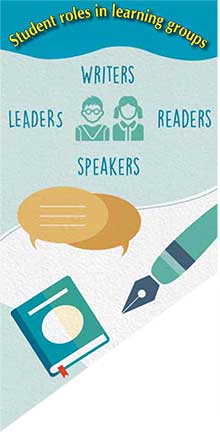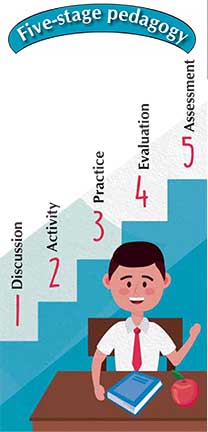An analysis of a (math) teacher’s pedagogy
Kinnari Pandya
Anyone who has taught children will know that teaching is a complex activity. The complexity of the teaching-learning process unfurls during the classroom interaction that the teachers have with students, and the methods teachers employ. The pedagogic processes that a teacher undertakes have been analyzed by many theorists and we now have different theoretical constructs available for understanding why a teacher does what she does, what her actions indicate – in terms of her own beliefs about learning and children, and how her actions implicitly influence the kind of educational experience children receive.
This article begins with a brief overview of a math teacher’s classroom, followed by an analysis of the pedagogy to help understand some theoretical constructs at play in a teaching-learning environment.
 A glimpse of the classroom
A glimpse of the classroom
The classroom had four windows and was well lit. There were 10 benches arranged in a U shape, one cupboard in a corner, a large blackboard and a table and chair for the teacher. The walls of the room were largely empty, with a notice board on the center wall. This board had an annual calendar of activities, and alongside were three rank charts with students’ names and their marks.
The blackboard had attendance data, name of the chapter being taught, a quote, the subject for that particular period, day and date.
The class
When I entered the school premises, it was recess and preparation for the Republic Day function was on. All the children were watching the rehearsals in the quadrangle from the corridors. Class VI A was on the 2nd floor. Their class teacher was standing with the students in the corridor. She said to the math teacher, “No teaching is happening today.” But the math teacher wanted to take the class, so all the children, hesitantly but quickly, went into the class.
A few boys, who were inside the class, quickly spread a large mat in the center of the classroom. The teacher told me that she had changed the classroom setting. All the benches were arranged in a U shape, two rows forming one side of the U. She asked the students to form groups. The students quickly made seven groups, 3 to 6 in each group. Five groups sat on the benches, two on the mat in the center of the room.
Teaching
The teacher was handling the topic of area and its measurement. She had set some ground rules and given different roles to the members of the groups – leaders, readers, writers, speakers. Every concept she taught, followed a five-stage pedagogy – discussion, activity, practice, evaluation and assessment. Each of these stages was done through some ‘chalk-and-talk’ and primarily through activity sheets, where children were supposed to solve the problems listed in their respective groups. She relied on students’ existing knowledge and shared understanding, expecting students to solve problems in groups and share their ideas with the whole class.
The following section illustrates and explains a few key theoretical constructs through an analysis of observations of her teaching.
“What is the difference between perimeter and area? Work in your groups and write down the differences in your activity sheet.”
This discussion stage activity seemed to aim to get a sense of the children’s thoughts on the concept of ‘area’. The teacher would have also got a sense of the children’s naïve or incomplete theories on the concept. Since she had not given any inputs on the concept yet, she tried to create a certain ‘disequilibrium’ (as Piaget refers to a state of thinking or mental churning wherein the child does not have a ‘stable’ understanding of a concept) in the students’ thinking by eliciting the difference between perimeter and area. Responses to the question would bring the understanding on area and perimeter in congruence with the same frame of reference as expected in the curriculum and within a mathematics textual community.
“Think, think. All have to discuss and learn together.” The teacher says this several times as she walks around the class.
A teacher’s beliefs about children and learning influences the way she plans her classroom transaction. The notion, ‘children as thinkers and knowledgeable’ is reflected in several processes during the classroom transaction. Use of these phrases – “Think. Think.”; “All have to discuss and learn” – as she walked around her class indicates her belief in this idea.
Supervising the class, she was moving around as a facilitator. To most queries by children from different groups, her response was, ‘think, think…’ after a certain cue. She gave general prompts and specific verbal instructions to each group who raised a query. The teacher’s own participation in most activities was minimal, giving a chance to all in the group to participate and solve problems. The students were confident that they could depend on and ‘recruit’ the teacher for help when needed.
One of the activities: The teacher asked all the students to look around the room for a square shape. There was none. One student pointed at the board. The teacher said that that was a rectangle. One of them pointed at a chart on the pin board. The teacher asked, “If you want to paint the chart, what will you need to find?” She asked another question, “If I want to paint the floor, or this carpet, then? It is also a rectangle. What do I need to find, area or perimeter?” The class responded, ‘area!’
The teacher seemed to treat the children as Piaget’s epistemologists. She successfully ‘inducted’ the students into the task and introduced examples of material that were familiar to them (a rectangular sheet of paper, board, mat, etc.) and clarified their notion about area and perimeter. By the above exercise, she was trying to ‘inculcate a certain way of thinking – conceptualizing and reasoning’.
 She hardly used didactic teaching, i.e., teacher-talk method where children are essentially listeners. As a facilitator, she used several scaffolds in the form of activity sheets she introduced in each stage of her pedagogy. Scaffolds are the support provided to strengthen a structure. Scaffolding is a process by which a teacher, a more knowledgeable adult, in the child’s environment, facilitates learning by giving cues, prompts, and pushing their threshold. The teacher here provided continuous scaffolding through different levels of questions in the activity sheets on discussion, activity, practice, evaluation and assessment.
She hardly used didactic teaching, i.e., teacher-talk method where children are essentially listeners. As a facilitator, she used several scaffolds in the form of activity sheets she introduced in each stage of her pedagogy. Scaffolds are the support provided to strengthen a structure. Scaffolding is a process by which a teacher, a more knowledgeable adult, in the child’s environment, facilitates learning by giving cues, prompts, and pushing their threshold. The teacher here provided continuous scaffolding through different levels of questions in the activity sheets on discussion, activity, practice, evaluation and assessment.
With each stage of this teacher’s pedagogy, one could observe ‘progressive reduction’ in her support to the students. This reduction in scaffolds was consistent with reduction in students’ ‘uncertainty/disequilibrium’ in dealing with the concept of area. The activity and practice exercises seemed to be helping students to appreciate the ‘regularities of the concept’. For instance, one of the first problems was finding the area of a ‘T’ shape-split figure. The teacher had given this problem to students soon after her first explanation of the concept. Most groups had not been able to solve this problem by discussion in their own groups and had to clarify their doubt directly with the teacher. But at the practice stage, the number of queries from the groups had reduced, along with the speed of solving the problems at each stage. One could also see that every practice sheet exercise was an effort to help the children ‘know what they know/not know’ and gather what strategy works for them to solve the problem.
Her class visibly followed a ‘participatory approach’ with regular intervention and focused on ‘collaborative learning’ – both approaches that are known to facilitate children’s learning and construction of knowledge.
Framing is a concept that suggests the extent to which the classroom experience is pre-planned and structured by the teacher. For instance, a teacher gives some material to children and encourages them to do whatever they want with it or gives some broad guidelines. Learning is implicitly driven in this exercise, and therefore, given the lack of a rigid structure to the exercise, we can say that it is a ‘weakly framed’ class. In contrast, when a teacher goes to a class with clear preparation of material, sheets, exact instructions to be given to the children, and the outcome of her interaction with the children, it will be referred to as a ‘strongly framed’ class. In the case of this teacher, she had planned each activity and step without consulting the students. She had taken a few suggestions from the class in identifying objects for measurement to understand the concept of area. As far as the process of organizing teaching and selection of tasks was concerned, it was a strongly framed class. However, there was an attempt to bring in knowledge from outside the textbook, and therefore this insulation of out-of-school-knowledge was rather weak. All the sheets – activity, discussion, practice, assignment, evaluation – had problems that were not from the ‘textbook’. So while the teacher completely controlled what would be ‘treated as knowledge’, her belief that children are knowledgeable led her to give opportunities to children to construct their own knowledge and led to a pedagogy that had scope for constructing knowledge.
Through the class, and as reflected in her five-stage pedagogy, the teacher gave special emphasis to the material and organization of content that contributed to the children’s growth in ability, i.e., the worksheets that had all out-of-textbook problems and levels of the exercises. This reflects the inter-relationship between the teacher’s ‘knowledge of subject’ and her ‘knowledge of her pupils’ thinking’. It is pertinent to state that the teacher here strongly believed in the idea of constructivism and had degrees in mathematics and psychology. She seemed to be very conscious of the theory she was following in class, and did not work only with her own (folk) notions about children.
In the little chalk-talk that she did while explaining the concept of area, none of the verbal questions had yes or no answers. She mainly asked questions to engage the children. For instance, “what length to choose?”, “what is square shaped in the classroom?”, etc. While explaining the concept, or seeking clarification of how the children dealt with their problems, she gave appropriate pauses in her questions, enough time, and cues to think about the answers. She established the right answers for each problem and authorized the children’s knowledge to be appropriate and valid. ‘Show-that-one knows’ is a relatively common practice among children in an environment that fosters competition. In the case of this teacher, this got triggered due to an attempt to recognize and appreciate good work, but was interpreted differently by other students, i.e., the teacher encouraged the class to give a round of applause to student S of group 8 when he solved a complex problem. Followed by this instance, in the practice stage of her class, student R in Group 1, clearly showed this feeling of knowing more than her group members hoping that if the next time the teacher asks who gave the idea to solve a particular problem, it would be she who would be appreciated. The intent of the teacher could be seen in the case of another student G, when he said, “I found the area…”, the teacher had immediately discouraged him from using ‘I’ and continued to emphasize that it had to be a ‘group’ effort. One can see that the teacher’s intent was to reinforce and appreciate in the case of S, but children infer such acts by the teacher to be something else and operate with a theory that leads to competition rather than appreciation. Moreover, given the emphasis on ranks as visible in the class, this need for recognition by Student R was obvious.
 Teachering device refers to actions by a teacher that reflect her authority and power in the classroom – for instance, calling out names of students, using the duster to get the attention of students, saying ‘silence!’, walking around the classroom – several common practices that implicitly convey a teacher’s authority in the classroom. This teacher used the device for seeking attention from students, getting them to concentrate and listen to her instruction – for instance, calling out, “Chottu, listen…” or moving around in the classroom often observing children’s work. Apart from that she didn’t really regulate the class in an authoritative manner, instead let the children be the way they were comfortable. One could say that the device seemed rather weak as in a couple of groups, one or two students were hardly contributing to the group discussions and whiling away time through the class (perhaps due to the large group size). But this wasn’t noticed or remarked by the teacher in the entire period. This could also be inferred as the teacher treating children to be autonomous and responsible.
Teachering device refers to actions by a teacher that reflect her authority and power in the classroom – for instance, calling out names of students, using the duster to get the attention of students, saying ‘silence!’, walking around the classroom – several common practices that implicitly convey a teacher’s authority in the classroom. This teacher used the device for seeking attention from students, getting them to concentrate and listen to her instruction – for instance, calling out, “Chottu, listen…” or moving around in the classroom often observing children’s work. Apart from that she didn’t really regulate the class in an authoritative manner, instead let the children be the way they were comfortable. One could say that the device seemed rather weak as in a couple of groups, one or two students were hardly contributing to the group discussions and whiling away time through the class (perhaps due to the large group size). But this wasn’t noticed or remarked by the teacher in the entire period. This could also be inferred as the teacher treating children to be autonomous and responsible.
The idea of developing morality in children came into play only once in over an hour long class when she said, “Give space. You have to think how ma’am will walk”. This can be inferred as sensitizing the child to be more considerate towards others. Through the class, not a single right or wrong, good or bad behaviour of the children was emphasized when they were peeping into each other’s sheets during the evaluation stage, when they got up from their place, or when a couple of children were always not-so-engaged in what their group was discussing.
In this teaching-learning process, children too seemed to have developed their own (folk) theory about the teacher. This was evident when the teacher entered the class and all the children organized themselves as the teacher expected them to – spreading the mat, making groups, and so on. Through the class the children felt free to move around if required, talk, open the door whenever needed as they seemed to have understood the teacher’s attitude towards such things, and not being in a strictly disciplined environment.
Her pedagogy in the class made me wonder: how was she able to manage in a school system that was highly competitive? This inference is based on the ‘rank charts’ as the only kind of charts on the walls of the classroom. Perhaps as she said, her students were doing well and her practice in the classroom was not hampering their results but instead making them conceptually clear to solve any problems that were asked in the examination.
Conclusion
Observation of teaching practice, and a conceptual analysis of classroom practice could be an effective tool to understand the nuances of teaching-learning processes, especially how a teacher’s dispositions and beliefs influence her teaching, and the various theoretical constructs at play in the classroom. For a teacher, such analysis provides a lens to understand the complexity of her role and an opportunity to reflect on her own practices. In the above analysis it is apparent at several instances that a teacher’s model of the mind – notions about the ability of her students and ways of learning, is as important as her own knowledge of the subject. It is the complex and multilayered pedagogic processes in the teaching of different subjects that impact the entire educational course of a child. If the aim of education is to develop critical understanding through epistemic enquiry of disciplinary knowledge, it is the pedagogic process (apart from the textbook content) that largely determines the achievement of that aim. And a teacher’s agency is most instrumental in realizing this aim.
References
- Wood David, (1986), ‘Aspects of teaching and learning’ from Richards, M. and Light, P. Children of Social Worlds (Cambridge, Mass: Harvard University Press)
- Sarangapani, Padma (2003), Teaching and Learning from Construction School Knowledge, New Delhi: Sage
- Kumar, Krishna (1988), ‘Origin of India’s ‘Textbook Culture’, Comparative Education Review 32(2), Pg 452-464
- Bruner, J (1999), ‘Folk Pedagogies’ in Leach, Jenny and Moon, Bob (eds) Learners and Pedagogy, London: Paul Chapman Publishing in Association with the Open University, Pg 4-20
- Keddie, Nell (1970), Classroom Knowledge from Young, MFD (Ed), Knowledge and Control (London: collier Macmillan)
- Giroux, Henry (2004), ‘Teachers as Transformative Intellectuals’ in Canestrari, A S and Marlowe, B A(eds), Educational Foundations: An anthology of critical readings (Thousand Oaks: Sage Publications)
Acknowledgement: My sincere thanks to the teacher and children whose class I observed.
The author is Assistant Professor at Azim Premji University. She can be reached at kinnari@apu.edu.in.
